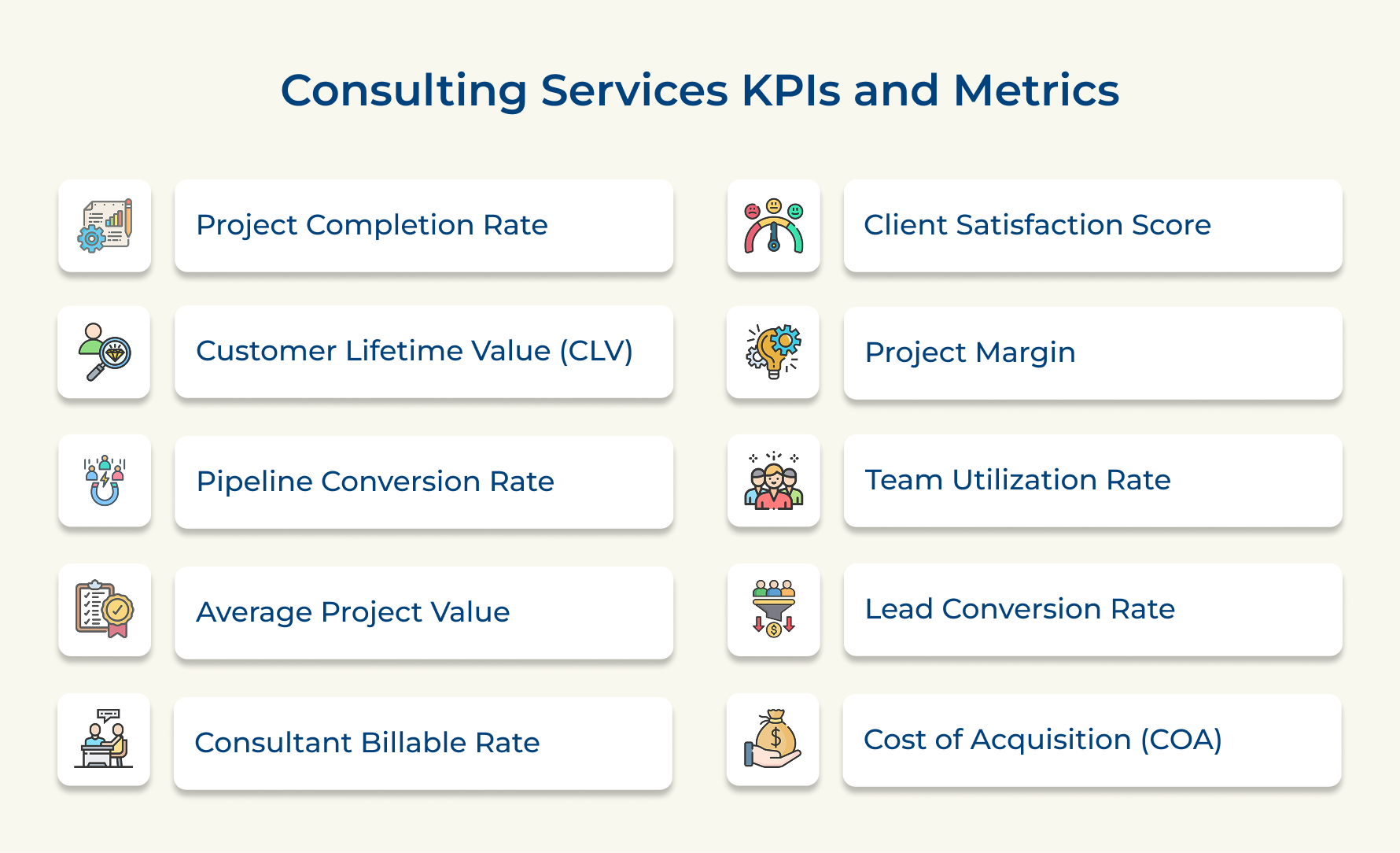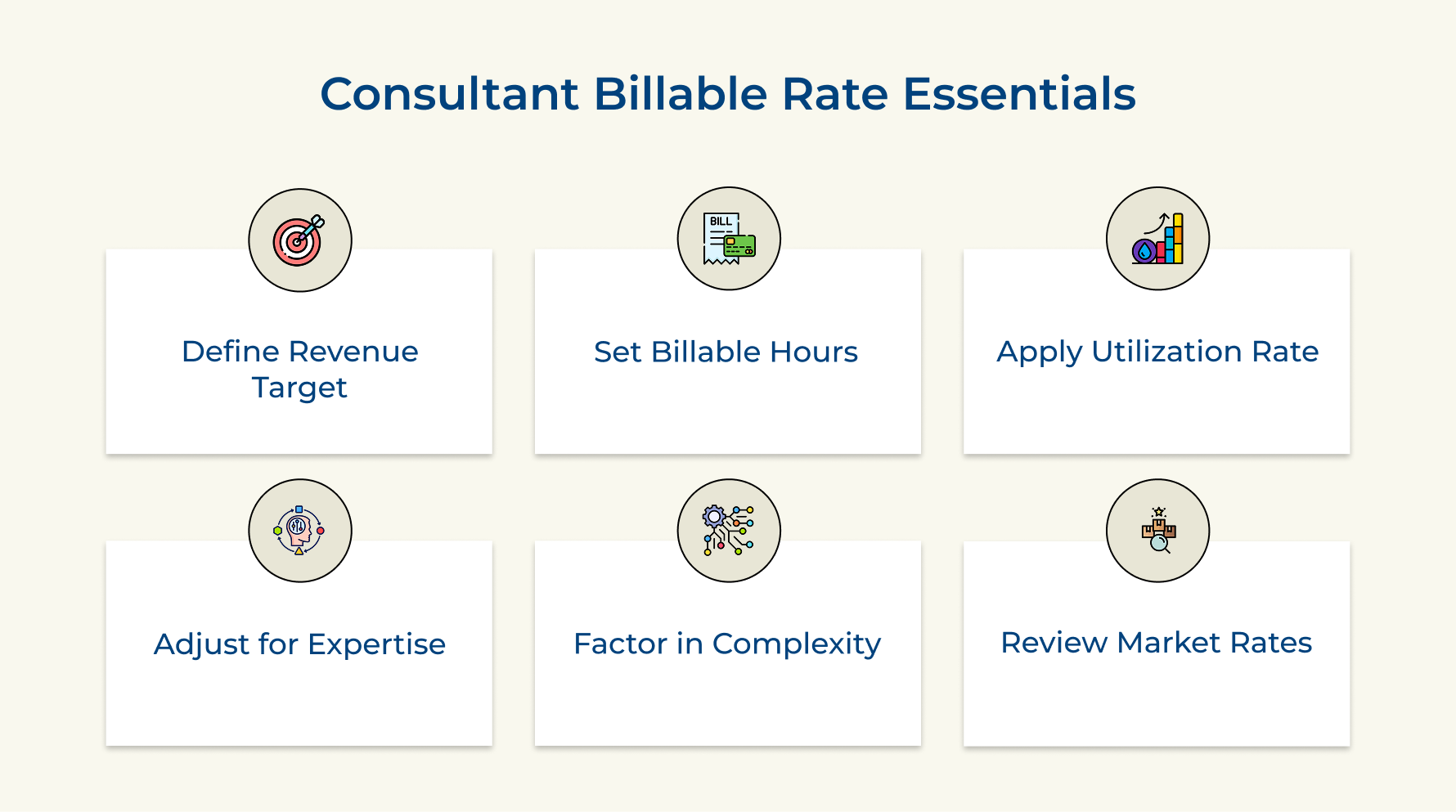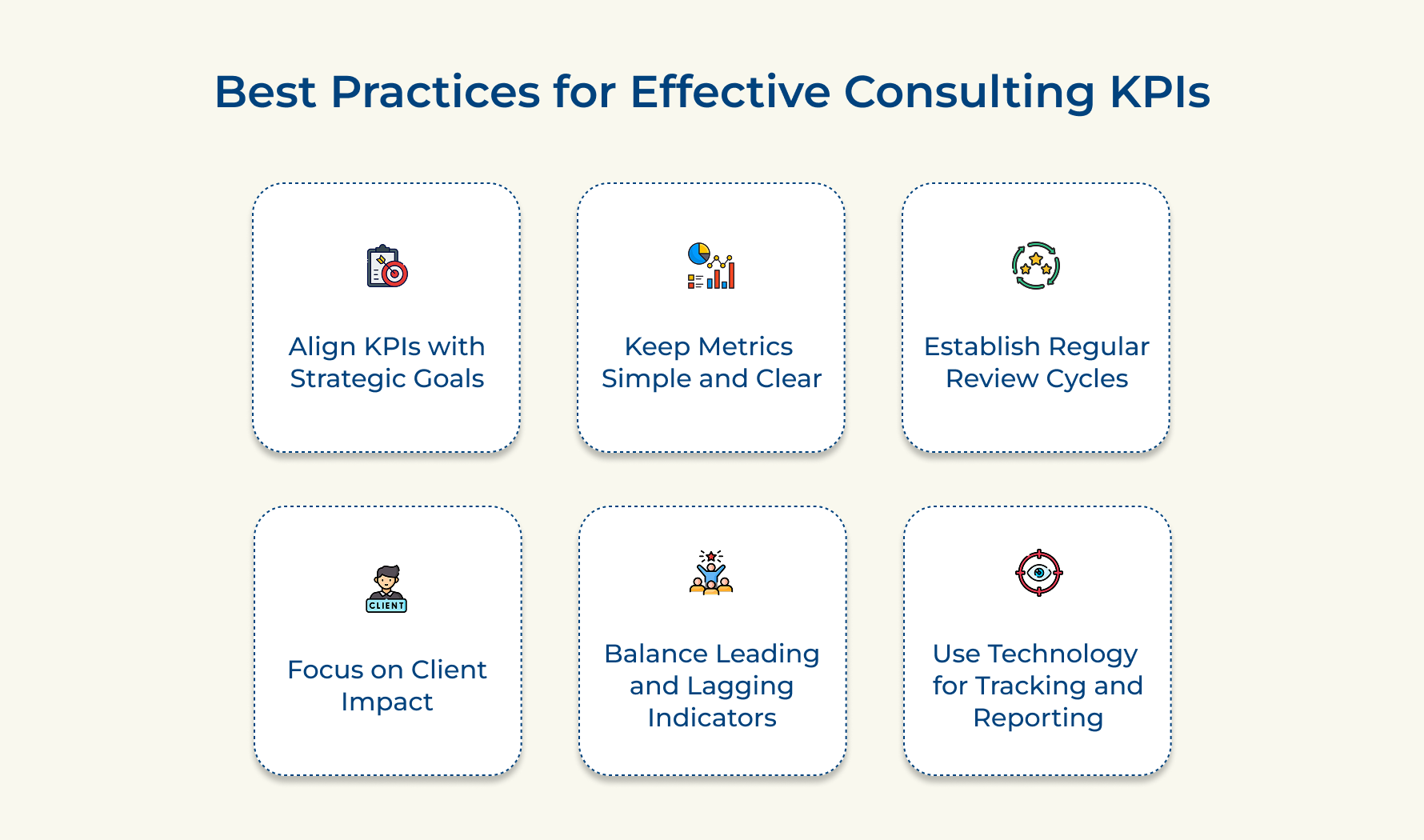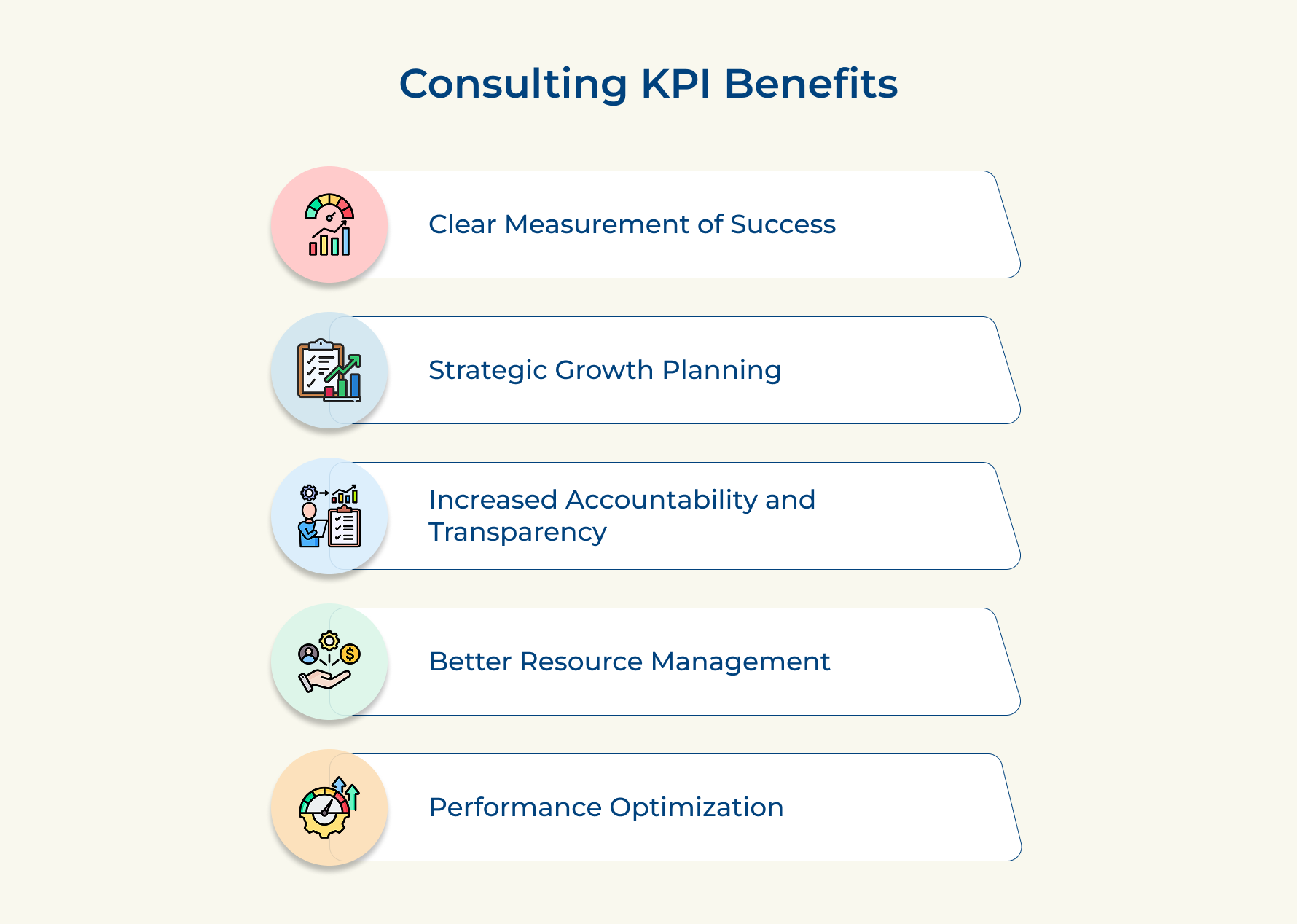10 Consulting Services KPIs Every Service Firm Must Track

Key Highlights:
- Consulting services KPIs help firms track performance, optimize resources, and drive strategic growth by aligning measurable metrics with business goals.
- Data-driven insights from key performance indicators enhance project efficiency, improve client satisfaction, and streamline decision-making.
- Tracking consulting KPIs boosts accountability, transparency, and profitability by identifying trends while ensuring effective resource allocation.
Are you struggling to keep your consulting firm competitive and growing sustainably? Tracking performance and making data-driven decisions becomes a challenge without clear success indicators.
Poor performance tracking doesn’t just hurt your bottom line—it can lead to unhappy clients, delayed projects, and missed profitability targets. The solution? Tracking the right key performance indicators!
These consulting services KPIs offer valuable insights, helping you make smarter decisions and optimize performance. In this blog, we’ll break down the essential KPIs every consulting firm should monitor to stay ahead of the competition.
What are Consulting KPIs?
Consulting Key Performance Indicators (KPIs) are quantifiable metrics used to measure and evaluate the overall performance of consulting services as well as operations. These metrics help consulting firms and individual consultants track their progress as well as identify areas for improvement while also demonstrating value to clients.
Well-defined KPIs also help in setting clear expectations, monitoring project progress, and ensuring alignment between consulting deliverables as well as client objectives. Moreover, these metrics facilitate better resource allocation, help identify bottlenecks, and support data-driven improvements in service delivery.
Key objectives:
- Financial performance measurement: Track revenue growth, project profitability, utilization rates, and billing efficiency to ensure sustainable business operations while maximizing returns on consulting investments.
- Client satisfaction and retention: Monitor client feedback, project success rates, repeat business percentages, and referral rates to maintain strong client relationships.
- Project delivery excellence: Assess on-time completion rates, budget adherence, milestone achievement, and implementation success to ensure consistent delivery of high-quality consulting services.
- Team performance and development: Evaluate consultant productivity, skill development, innovation contribution, and knowledge sharing to maintain a high-performing consulting team capable of delivering superior results.
10 Consulting Services KPIs and Metrics to Track
Tracking the KPIs can be a game-changer for your consulting business when done right! Let’s explore all the metrics you should track to stay ahead of the game.
Project Completion Rate
Delivering projects on time and within budget is key to a consulting firm’s success. The project completion rate helps you track how efficiently your team executes projects. Let’s break it down!
- Measures how many consulting projects are completed on time and within budget.
- Helps track project management efficiency and resource utilization.
- A high rate means smooth execution, while a low rate may point to delays, resource issues, or scope creep.
How to calculate?
(Number of Successfully Completed Projects / Total Number of Projects) × 100 Include only projects that meet all success criteria (time, budget, scope).
Evaluate completion status against original project specifications and client expectations.
Actionable tips:
- Implement milestone-based tracking systems with clearly defined success criteria for each project phase, enabling early identification of potential delays or issues.
- Develop a standardized project closeout process that includes client sign-off and team retrospectives to continuously improve completion rates.
Customer Lifetime Value (CLV)
Customer Lifetime Value (CLV) is the total revenue a consulting firm can expect from a client throughout the entire relationship. It includes all projects and services provided over time.
Knowing your CLV helps you focus on the right clients, allocate resources wisely, and make better decisions about acquiring new clients.
Calculate it using the following formula:
Average Project Value × Average Projects Per Year × Average Client Relationship Duration (Years) × Profit Margin Track and adjust based on historical client data as well as industry benchmarks.
Tips to consider:
- Create client health scorecards to monitor engagement levels and proactively identify opportunities for relationship expansion.
- Develop targeted retention strategies for high-CLV clients, including dedicated relationship managers and customized service offerings.
Pipeline Conversion Rate
Pipeline Conversion Rate measures the success rate of converting prospective opportunities into actual client engagements, tracking proposals through various stages of the sales process.
This metric helps optimize sales efforts, resource allocation, and proposal strategies. It provides insights into market positioning along with the effectiveness of business development activities.
Formula to calculate:
(Number of Won Opportunities / Total Number of Proposals Submitted) × 100 Track conversion rates at each pipeline stage to identify specific improvement areas.
Pro tips:
- Establish a structured qualification process to focus efforts on high-probability opportunities and improve overall conversion rates.
- Implement regular proposal reviews to identify successful patterns and refine approach strategies based on win/loss analysis.
Average Project Value
Average Project Value shows how much revenue you typically make from each consulting project. It gives you a clear picture of your pricing patterns and where your services stand in the market. Plus, it highlights trends in client spending and areas where you can add more value.
Calculate it using:
Total Project Revenue / Number of Projects (within a specified period) Consider segmenting by project type, client industry, or service line for deeper insights.
Tips to consider:
- Regularly analyze project scope and deliverables against value to identify opportunities for service enhancement and premium pricing.
- Develop value-based pricing models aligned with client outcomes rather than time-based billing.
Consultant Billable Rate
Consultant Billable Rate is the hourly or daily charge for your services, reflecting your market value. It drives profitability and market competitiveness as well as ensures sustainable revenue.
How to calculate this?
(Annual Target Revenue per Consultant) / (Available Billable Hours × Target Utilization Rate) Adjust for expertise levels, market conditions, and service complexity.
Actionable tips:
- Conduct regular market rate analyses to ensure competitive positioning while maintaining profitability targets.
- Implement value-based rate tiers aligned with consultant expertise and project complexity.
Client Satisfaction Score
Client satisfaction is a key indicator of your consulting business’s success. It helps you understand how well you’re meeting client expectations and where improvements are needed.
Why does it matter?
- Measure client contentment: Gather feedback through surveys or interviews to understand how clients feel about your services.
- Improves service quality: Identifies areas to improve, ensuring clients are consistently happy with the service provided.
- Boosts retention & referrals: Satisfied clients are more likely to return and refer others, helping you grow your business.
Calculation formula:
(Number of Satisfied Clients / Total Number of Surveyed Clients) × 100 For NPS: ((Number of Promoters – Number of Detractors) / Total Respondents) × 100
Pro tips to know:
- Implement automated satisfaction surveys at key project milestones to gather timely feedback and address issues promptly.
- Establish a closed-loop feedback system where client input directly influences service improvements and team training.
Project Margin
Project Margin measures the profitability of individual consulting engagements by calculating the difference between revenue and all associated delivery costs.
Tracking project margins ensures pricing adequacy, resource efficiency, and overall business sustainability. It helps identify unprofitable service lines and optimize delivery processes.
Calculation formula:
((Project Revenue – Total Project Costs) / Project Revenue) × 100 Include all direct and indirect costs, including consultant time, expenses, and overhead allocation.
Actionable tips:
- Develop detailed project budget templates that account for all cost components and potential contingencies.
- Establish regular margin review meetings to identify trends and implement corrective actions for underperforming projects.
Team Utilization Rate
The team utilization rate shows how much time consultants spend on billable client work compared to non-billable tasks. When utilization is high, profitability improves without sacrificing work quality or consultant satisfaction.
Formula to calculate:
(Billable Hours / Total Available Hours) × 100 Track both individual and team-level utilization, accounting for holidays & planned leave.
Pro tips to consider:
- Implement real-time utilization tracking tools to enable proactive resource management and workload balancing.
- Create clear guidelines for billable versus non-billable activities to ensure consistent tracking across teams.
Lead Conversion Rate
Lead Conversion Rate measures the effectiveness of converting initial client inquiries or leads into qualified opportunities and eventually paying clients.
Understanding lead conversion helps optimize marketing efforts, improve sales processes, and allocate business development resources effectively.
How do you calculate this?
(Number of Converted Leads / Total Number of Leads) × 100 Track conversion rates at each stage of the sales funnel.
Tips:
- Create a lead scoring system to prioritize high-potential opportunities and focus resources effectively.
- Establish regular lead nurturing touchpoints with automated follow-up processes for consistent engagement.
Cost of Acquisition (COA)
The cost of acquisition measures how much it costs to bring in a new consulting client. This includes marketing, sales, and business development expenses.
Knowing this cost helps you optimize your marketing budget, see which channels work best, and ensure you’re building profitable client relationships from the start.
Calculation formula:
Total Sales & Marketing Costs / Number of New Clients Acquired Include all direct and indirect costs associated with client acquisition efforts.
Tips:
- Track acquisition costs by marketing channel to identify the most cost-effective client acquisition methods.
- Establish maximum acceptable COA thresholds based on expected client lifetime value and profit margins.
Best Practices for Effective Consulting KPIs
Tracking the right KPIs is key to consulting success, but how you track them makes all the difference. Let’s dive into the best practices for setting up and using KPIs effectively!
Align KPIs with Strategic Goals
Your KPIs should directly support your firm’s big-picture goals and client success. Instead of tracking random metrics, focus on ones that truly reflect your value and progress.
Keep Metrics Simple and Clear
Complex metrics can lead to confusion. Choose a handful of key indicators that everyone—consultants and clients alike—can easily understand as well as act on.
Establish Regular Review Cycles
Don’t just set KPIs and forget them! Reviewing them monthly or quarterly helps spot trends, make adjustments, and stay on track with long-term goals.
Focus on Client Impact
The best KPIs measure the actual value you bring to your clients. Focus on both immediate project results and long-term success to strengthen relationships while proving your ROI.
Balance Leading and Lagging Indicators
Use a mix of leading indicators (which predict outcomes) and lagging indicators (which confirm past results). This gives you a well-rounded view of performance.
Use Technology for Tracking and Reporting
Tracking KPIs manually is a hassle. Use dashboards and automation tools to monitor performance in real time, helping your team make quick, data-driven decisions.
Benefits of Having Consulting KPIs
Tracking the right KPIs helps consulting firms stay on top of performance, optimize operations, and drive client success. Here’s why these KPIs are beneficial:
Clear Measurement of Success
KPIs give you a concrete way to track your consulting firm’s performance. Whether it’s revenue growth, client satisfaction, or project timelines, these metrics help you see where you stand and if you’re moving in the right direction.
Strategic Growth Planning
Want to grow smart? KPIs highlight trends, market opportunities, and areas to expand or refine your services. With data-driven insights, you can make informed decisions that minimize risks and maximize returns.
Increased Accountability and Transparency
Setting clear KPIs keeps everyone on the same page. Your team knows what’s expected, progress is easy to track, and performance stays transparent—making accountability a breeze.
Better Resource Management
Struggling with overworked teams or underused resources? KPIs help you spot inefficiencies, ensuring time, budget, and talent are used wisely for maximum impact.
Performance Optimization
Tracking the right metrics uncovers bottlenecks and areas for improvement. With this insight, you can tweak processes, enhance efficiency, as well as ensure smoother project delivery—leading to better results for both your firm and your clients.
Driving Growth with Effective Consulting Services KPIs
Agencies can unlock significant growth potential by focusing on key performance indicators. Consulting services KPIs provide a clear understanding if improvements can be made in client acquisition, project delivery, or financial performance.
Professional service organizations that track these metrics effectively can drive better results, improve client satisfaction, and optimize their operations for scalability. Implementing KPIs ensures that consulting businesses remain proactive, focused, and poised to achieve long-term growth as well as success.
Limit time — not creativity
Everything you need for customer support, marketing & sales.
Neeti Singh is a passionate content writer at Kooper, where he transforms complex concepts into clear, engaging and actionable content. With a keen eye for detail and a love for technology, Tushar Joshi crafts blog posts, guides and articles that help readers navigate the fast-evolving world of software solutions.



